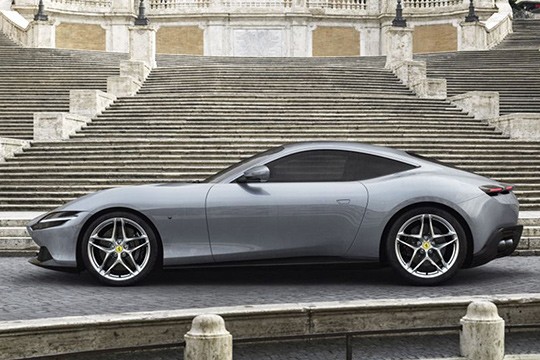FERRARI Roma Models/Series Timeline, Specifications & Photos
First production year: 2019
Engines: Gasoline
Body style: Coupé (two-door)
In 2019, Ferrari introduced a new base model in its lineup, namely the Roma, and built it on the same platform and with the same 3.9-liter turbocharged V8 as the Portofino, but with a completely different interior.
The Italian automaker had a weak spot for mid-front mounted engines, reserving the mid-ship solutions only for the fastest ones in its lineup. But even if the Roma was the entry-level Ferrari, that didn’t mean that it was slow. It was very fast and could carry four people inside its cabin. In addition, the automaker’s design studio, led by Flavio Manzoni, created a gran touring shape for the car. Furthermore, the Roma boasted a high level of technology, making a complete package for its customers that included not just a beautiful shape but also an advanced platform in all areas.
From the outside, the long and low nose of the vehicle started with a set of LED headlights that were flush with the curved shapes of the front fenders. The daytime running lights created the illusion of splitting the headlamps into an upper and a lower side. The bumper sported the main grille where the carmaker’s badge took center stage. In addition, in the apron, Ferrari installed a second, broad grille and a splitter underneath it. From its profile, the cab-rearward design was emphasized by the sloped-down roofline, which ended into a wide rear window. The enlarged rear quarter panels made the vehicle look muscular but elegant at the same time. Finally, the rear fascia featured a very complicated design, with a crease under the upper section and LED taillights. Under the bumper, the automaker installed a diffuser and two pairs of round exhausts on each side of the vehicle.
Inside, Ferrari arranged a 2+2 cabin layout with two high-bolstered bucket seats at the front and a bench seat profiled for two behind them. The transmission tunnel split the cabin into two areas, crossing the cabin from front to back. Fronting the driver was a digital instrument cluster with a center-mounted tachometer flanked by additional screens for the onboard computer data, navigation, and media system. The driver fronted a flat-bottom steering wheel with two large paddle shifters for situations when they wanted to manually change gears. On the sloped center stack, the automaker placed the touchscreen for the HVAC system, while the center console housed the automatic transmission controls and a cup holder. In the back, there was hardly room for grown-ups, but those were fine for short jaunts.
Underneath the hood, Ferrari installed a 3.9-liter turbocharged engine mated with an eight-speed automatic (dual-clutch) gearbox that sent all the oomph to the rear wheels via an electronically-controlled limited-slip differential. The new gearbox was six kilos (13 lbs.) lighter than the seven-speed transmission offered on the Portofino.
